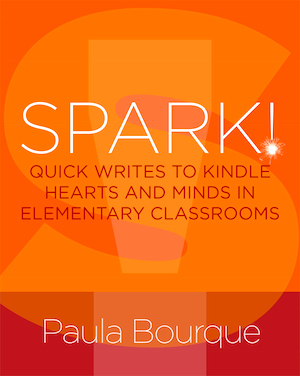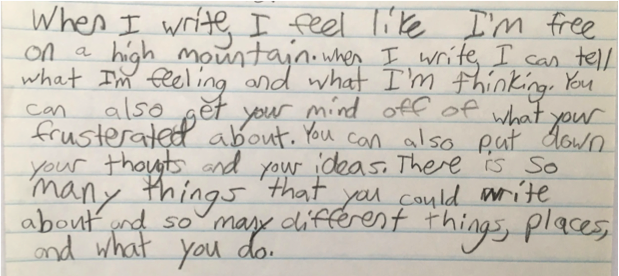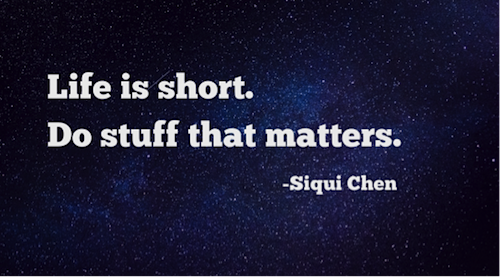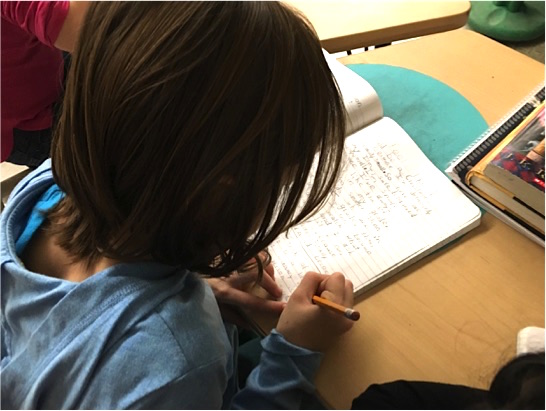How a Tiny Spark Can Ignite Student Writing
We write for so many reasons, from practical to poetical. I want my students to embrace writing as a way of being human. Sadly, too many never fully realize the potential writing can bring to their lives. These children need a spark to ignite that passion, creativity, and awareness.
I also know that time is a precious commodity in schools, so we need to spend it doing stuff that matters. Kindling our students’ hearts and minds doesn’t require excessive amounts of time, but it does require intention. I never want to do, or ask teachers to do, stuff that doesn’t matter. We just don’t have that luxury of time. For me, quick writing has been an effective and fun way of doing stuff that matters. — from Spark!
Writing Matters
Writing is a skill that is uniquely human. It offers a means of catharsis, communication, and creativity that enhances our lives as human beings, and yet far too many students dislike and disengage from it while others may complete the task but not embrace the power of the pen.
If we only teach kids how to write but not why it matters, they will never be lifelong writers. And why does that matter? A quote from George Orwell illustrates my sense of urgency, “If you cannot write well, you cannot think well; if you cannot think well, others will do your thinking for you.” We need to be raising a generation of citizens, of human beings, who can think well.
Writing is thinking. It doesn’t just reflect our thinking – it shapes it. As we write, our brains are synthesizing, summarizing, organizing, and determining what is important. Writing is generative; opening up new avenues of thinking, fostering curiosity, and leading to discovery. As Isaac Asimov said, “Writing, to me, is simply thinking through my fingers.”
We need our students to think through their fingers beyond writing workshop and in other content areas and outside of their academic lives. They need to think like mathematicians, scientists, artists, sociologists, and human beings.
Quick writes throughout the day give our students time to think through their fingers to discover what they know, and quick writes don’t require a large investment of time.
What Are Quick Writes?
You may be familiar with the quick writes Linda Rief, Penny Kittle, and Don Graves use with student writers. In The Quick Write Handbook, Linda uses mentor texts to stimulate thinking. She calls this “riding the wave of someone else’s words.” She considers this writing to find writing.
While I wholeheartedly embrace this approach, I also use quick writes as writing to discover thinking and stimulate curiosity. Mentor texts and poetry may provide one stimulus, but I have pulled together a variety of “sparks” to kindle my students’ hearts as well as their minds.In my book Spark! I define them this way:
Short and frequent bursts of low-stakes writing in response to a stimulus (spark), that do not allow for planning, revising, or overly cautious forethought. They are thinking on paper and help students creatively explore ideas while boosting their volume of writing.
In other words, students are thinking and inking. So while a mentor text may help students find worthy writing, other sparks can help my students find themselves in the words they put to paper.
The key is to offer lots of opportunities to do this. Short bursts of low-stakes writing can be sprinkled throughout our teaching so students can playfully, creatively, and authentically explore ideas without the worry of being graded or judged.
We can break down that academic wall of writing that sometimes separates a writer from his writing. We can remove the filter of someone else’s expectations so that students are free to let ideas flow.
The only expectation is to keep the pencil moving, to let their thinking happen on the paper and not just inside their heads. As Don Murray says, “Write fast – write badly – so you will write what you don’t yet know you knew, and so you will outrun the censor within us all.”
Five Benefits of Quick Writes
As we’ve regularly used quick writes in classrooms the past few years, I’ve noticed some distinct benefits for our students in addition to building writing skills. Quick writes:
► Boost the volume of low stakes writing. You only get better at something by doing it – a lot. Many of our students fall into the category of reluctant writers because they don’t have confidence or don’t make a personal connection with the writing they do for grades. I believe if we lower the stakes we can invite greater risk-taking and then a greater volume of writing occurs. When students begin to believe “Oh, I can do that,” they do it.
► Develop valuable “soft skills” beyond literacy. Literacy development is critically important to my students, but I believe supporting their development as human beings is an even higher priority. Quick writes that encourage critical thinking, creativity, communication, empathy, understanding, mindfulness, and even collaboration will bolster both on the page and off the page skills.
► Reset students’ default approach to writing. Do you have students who suffer from writers’ block or seem to approach their writing in a predictable or stagnant way? When they are asked to initiate a variety of writing pieces daily or weekly, that blank paper becomes less intimidating.
Students can experiment with a variety of entry points and play around with ideas and not worry about creating a long-term relationship with a piece of writing they may not love. The focus is on process, not product, so they become more in tune with how they approach their writing.
► Strengthen relationships with our students. We can learn so much about our students through their writing (and if we are courageous enough to share our writing, that knowledge becomes reciprocal). We can nurture empathy and understanding when we can appreciate the experiences and beliefs of others.
In classrooms where students are taught how to share their quick writes in a safe and respectful environment, we create a community that learns to support one another and feel invested in everyone’s success. Writing often makes us feel vulnerable – appreciating that vulnerability in others can break down barriers and help us see one another more compassionately. We could sure use more of that these days.
► Increase enjoyment of writing. Let’s face it. We don’t do what we don’t enjoy, so we can’t expect our students to make writing a habit unless they find joy in it. While some quick writes can encourage deep reflection, others can trigger joy and laughter. Variety keeps the activity fresh and the interest level high.
Knowing these bits of writing are short and that they can be shared can be quite gratifying for many students. I don’t use quick writes as extended skill and drill – they need to expand students’ concept of and appreciation for writing. Think Marie Kondo and ask yourself, “Does this spark joy?” Toss it out if it doesn’t!
How Can You Use Quick Writes?
As always, I encourage teachers to think about purpose. To get started, your purpose may be to simply increase the volume of writing for your students. Look for opportunities where thinking on paper could replace a five-minute conversation. These could happen before, during, or after a lesson.
BEFORE: So what have we learned so far about____? What are you wondering about _____? What do you already know about____? What do you predict will happen with____ today?
DURING: What does that mean to you? What can you infer about___? Stop and jot what you are thinking/wondering. What would you like to ask that character right now?
AFTER: What did you learn about____today? What do you hope to remember about___? What are your big takeaways? What are you still wondering or curious about___?
These think-quick writing opportunities make great formative assessments to see what your students already know, are learning, are curious about, may have misconceptions with, or are interested in. They allow for 100% engagement from everyone and not just from the eager hand-raisers in class.
I also use quick writes for a variety of other purposes. I have organized my book by chapters to include sparks for:
- Emerging writers: to develop automaticity and fluency at the letter, word, and sentence level.
- Information: to activate prior knowledge, stimulate curiosity, and express opinions.
- Appreciation: to respond to a variety of art in visual, auditory, and verbal formats.
- Creativity: to promote more playful practice when composing and communicating.
- Social-Emotional: to nurture mindfulness, metacognition, and mindset.
- Teacher: to inspire teachers to walk the talk of a writer.
My advice is to jump in and make quick writes a routine in your classroom. With a small investment of time and some tiny sparks, I believe you can ignite a writing life for – and with – your students.
__________

Paula is a K-6 literacy/instructional coach in Augusta, Maine. A 30-year educator, she is an NBCT with a background in both English Language Arts and Reading Recovery.
Paula’s first book for Stenhouse, Close Writing: Developing Purposeful Writers in Grades 2-6, was also inspired by her interest in the relationships young writers develop with their own writing.



































I love this! I didn’t know what it’s called but I apparently have been doing “quick write” since I was little. Sometimes, when I encounter thoughts that I feel like I want to share and I have no one to share it with, I write it down… and then totally forget about it. Then years later I would find them and they make me revisit that particular idea and allow myself to compare the way I think then and now, and subsequently reflect on how much I’ve grown over time.